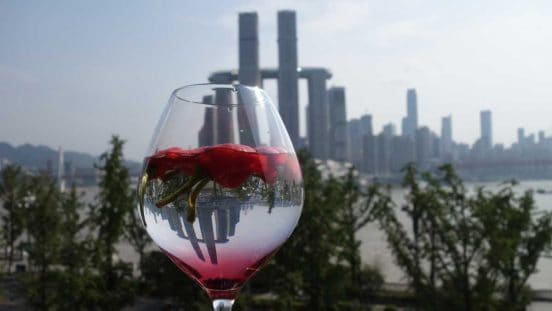Chongqing hot pot is always talked about as boiling cauldrons of fire. As an experience that is loud and interesting, but not the greatest joy.
The restaurant “Yanshe Featured Hot Pot” of Dezhuang Group shows that a deluxe hot pot experience is possible.
The location on Nanbin-lu in Chongqing alone shows a different side of the city.
Nanbin-lu is receiving considerable support as a showcase of what Chongqing is and can be; it holds fancy malls, company offices and expensive housing.
From Yanshe’s balcony, the view goes over to the peninsula between the Yangtze and the Jialing which forms the old core of Chongqing – and the Raffles City towers now newly standing there.

The restaurant itself shows what China also has to offer – not least, elegance.

The food, so often seen as a sideshow to hot pot’s raucous social function, is of the highest quality, too.
The first and distinguishing feature of the hotpot here: Every diner has their own (double) pot.

Dezhuang also uses the Li’s Spicy Scale they created – and so does this restaurant of theirs here. Here at Yanshe, that means that every individual diner is asked what heat level – what “spicy degrees” – they would like their hot pot to have.
First await some fruit and an appetizer.

Then, for the beginning of the hot pot meal, there is beef (which is imported wagyu – and if it isn’t wagyu, it’s of a level like that), maodu and ecang.
These latter two are, well, interesting.
Maodu is beef tripe; ecang is goose intestine.
If you think that sounds like they must have a strange taste, you’d be completely wrong. There is hardly any taste to them – and even less after the few seconds they are supposed to be moved through the hotpot.


What these ingredients are about is the mouthfeel, the kougan, they have. The special texture.
They have a certain bite, al dente-style, and are still rather soft than hard; they don’t exactly melt in your mouth, but don’t crack crispily, either; it’s a certain chewiness they show…

And next, seafood. Different muscles, shrimp, fish.
The recommendation for those is to put them into the white, non-hot, “soup” (which is a chicken stock, some of which is also ladled out at one point early in the meal, to be drunk as an appetizer).
Then there may be an assortment of fungi…

… as well as vegetables.

And tofu.

On the left side of the image above are the breaded pork pieces, spiced up with huajiao (Sichuan pepper), of which I became particularly fond.
There was also, usually, a ‘course’ of some meat, meat and fish balls.
Taking a cue from Western traditions, the meal often ends with something sweet; they make a mean mango pudding – or, rather more traditional, there are tangyuan (black sesame paste-filled glutinous rice balls, warm, in a lightly sweetened warm broth).

Yanshe Featured Hot Pot is quite the contrast to Chongqing’s other few thousand hot pot restaurants.
There, things get more raucous – and one could argue that that is really the function of hot pot.
Even such traditions should adapt and change, though, and Yanshe is a fascinating example of the opportunities that would be there!

Leave a Reply
You must be logged in to post a comment.